
Feathers suppress sound to help catch prey
A new study suggests long-eared owls are able to suppress noise caused by wing vibrations, allowing them to swoop down on their prey undetected.
Chinese scientists hope that their findings may have practical applications, helping engineers to develop materials or structures with mechanical noise elimination.
Many types of owls are known to possess silent hunting abilities - something that has long been of interest to engineers. Bionic designs for fans and gliders, for example, have been influenced by the structure of owl feathers.
Previous studies have focused on the owl's ability to suppress aerodynamic noise. Scientists from the Dalian University of Technology in China, however, also studied the mechanical noise caused by vibrations during flight.
Laser sensors and high speed cameras were used to analyse and compare the flight of silent long-eared owls with noisy flying birds, golden eagles and pigeons.
Long-eared owls were found to have superior 'damping' abilities compared to the other two birds. Damping is the ability to eliminate mechanical noise by extracting mechanical energy and converting it into heat.
According to lead author Professor Jinkui Chu, the species is "the king of acoustic stealth". He told The Guardian: “Our research showed the long-eared owl has superior damping skill, meaning it can remain mind-blowingly stable and eliminate mechanical noise caused by the movement of its feathers - quite a feat of engineering.”
The research has been published in the journal Bioinspired, Biomimetic and Nanobiomaterials: http://www.icevirtuallibrary.com/content/article/10.1680/bbn.15.00003



 BSAVA is to partner with BVA Live (11-12 June 2026) to champion clinical research.
BSAVA is to partner with BVA Live (11-12 June 2026) to champion clinical research.